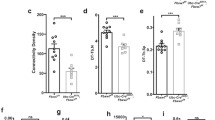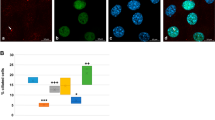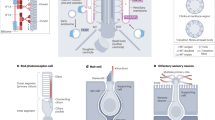Abstract
Primary cilia are microtubule-based organelles involved in signal transduction and project from the surface of most vertebrate cells1. Proteins that can localize to the cilium, for example, Inversin and Bardet-Biedl syndrome (BBS) proteins, are implicated in both β-catenin-dependent and -independent Wnt signalling2,3,4. Given that Inversin and BBS proteins are found both at the cilium and elsewhere in the cell, the role of the cilium itself in Wnt signalling is not clear. Using three separate mutations that disrupt ciliogenesis (affecting Kif3a, Ift88 and Ofd1)5,6,7, we show in this study that the primary cilium restricts the activity of the canonical Wnt pathway in mouse embryos, primary fibroblasts, and embryonic stem cells. Interestingly, unciliated cells activate transcription only in response to Wnt stimulation, but do so much more robustly than ciliated cells. Loss of Kif3a, but not other ciliogenic genes, causes constitutive phosphorylation of Dishevelled (Dvl). Blocking the activity of casein kinase I (CKI) reverses this constitutive Dvl phosphorylation and abrogates pathway hyper-responsiveness. These results suggest that Kif3a restrains canonical Wnt signalling both by restricting the CKI-dependent phosphorylation of Dvl and through a separate ciliary mechanism. More generally, these findings reveal that, in contrast to its role in promoting Hedgehog (Hh) signalling, the cilium restrains canonical Wnt signalling.
This is a preview of subscription content, access via your institution
Access options
Subscribe to this journal
Receive 12 print issues and online access
$209.00 per year
only $17.42 per issue
Buy this article
- Purchase on Springer Link
- Instant access to full article PDF
Prices may be subject to local taxes which are calculated during checkout





Similar content being viewed by others
References
Singla, V. & Reiter, J. F. The primary cilium as the cell's antenna: signaling at a sensory organelle. Science 313, 629–633 (2006).
Simons, M. et al. Inversin, the gene product mutated in nephronophthisis type II, functions as a molecular switch between Wnt signaling pathways. Nature Genet. 37, 537–543 (2005).
Ross, A. J. et al. Disruption of Bardet-Biedl syndrome ciliary proteins perturbs planar cell polarity in vertebrates. Nature Genet. 37, 1135–1140 (2005).
Gerdes, J. M. et al. Disruption of the basal body compromises proteasomal function and perturbs intracellular Wnt response. Nature Genet. 39, 1350–1360 (2007).
Yoder, B. K. et al. Polaris, a protein disrupted in orpk mutant mice, is required for assembly of renal cilium. Am. J. Physiol. Renal Physiol. 282, F541–F552 (2002).
Marszalek, J. R., Ruiz-Lozano, P., Roberts, E., Chien, K. R. & Goldstein, L. S. Situs inversus and embryonic ciliary morphogenesis defects in mouse mutants lacking the KIF3A subunit of kinesin-II. Proc. Natl Acad. Sci. USA 96, 5043–5048 (1999).
Ferrante, M. I. et al. Oral-facial-digital type I protein is required for primary cilia formation and left-right axis specification. Nature Genet. 38, 112–117 (2006).
Nusse, R. Wnt signaling in disease and in development. Cell Res. 15, 28–32 (2005).
Wallingford, J. B. & Habas, R. The developmental biology of Dishevelled: an enigmatic protein governing cell fate and cell polarity. Development 132, 4421–4436 (2005).
Rosenbaum, J. L. & Witman, G. B. Intraflagellar transport. Nature Rev. Mol. Cell Biol. 3, 813–825 (2002).
Maretto, S. et al. Mapping Wnt/beta-catenin signaling during mouse development and in colorectal tumors. Proc. Natl Acad. Sci. USA 100, 3299–3304 (2003).
Sulik, K. et al. Morphogenesis of the murine node and notochordal plate. Dev. Dyn. 201, 260–278 (1994).
Kaykas, A. et al. Mutant Frizzled 4 associated with vitreoretinopathy traps wild-type Frizzled in the endoplasmic reticulum by oligomerization. Nature Cell Biol. 6, 52–58 (2004).
Binnerts, M. E. et al. R-Spondin1 regulates Wnt signaling by inhibiting internalization of LRP6. Proc. Natl Acad. Sci. USA 104, 14700–14705 (2007).
Huangfu, D. et al. Hedgehog signalling in the mouse requires intraflagellar transport proteins. Nature 426, 83–87 (2003).
Ulloa, F., Itasaki, N. & Briscoe, J. Inhibitory Gli3 activity negatively regulates Wnt/beta-catenin signaling. Curr. Biol. 17, 545–550 (2007).
Iwatsuki, K. et al. Wnt signaling interacts with Shh to regulate taste papilla development. Proc. Natl Acad. Sci. USA 104, 2253–2258 (2007).
Varjosalo, M., Li, S. P. & Taipale, J. Divergence of hedgehog signal transduction mechanism between Drosophila and mammals. Dev. Cell 10, 177–186 (2006).
Teng, J. et al. The KIF3 motor transports N-cadherin and organizes the developing neuroepithelium. Nature Cell Biol. 7, 474–482 (2005).
Haraguchi, K., Hayashi, T., Jimbo, T., Yamamoto, T. & Akiyama, T. Role of the kinesin-2 family protein, KIF3, during mitosis. J. Biol. Chem. 281, 4094–4099 (2006).
Tuma, M. C., Zill, A., Le Bot, N., Vernos, I. & Gelfand, V. Heterotrimeric kinesin II is the microtubule motor protein responsible for pigment dispersion in Xenopus melanophores. J. Cell Biol. 143, 1547–1558 (1998).
Schneider, L. et al. PDGFRalphaalpha signaling is regulated through the primary cilium in fibroblasts. Curr. Biol. 15, 1861–1866 (2005).
Sato, A. et al. Profilin is an effector for Daam1 in non-canonical Wnt signaling and is required for vertebrate gastrulation. Development 133, 4219–4231 (2006).
Yanagawa, S., Lee, J. S. & Ishimoto, A. Identification and characterization of a novel line of Drosophila Schneider S2 cells that respond to wingless signaling. J. Biol. Chem. 273, 32353–32359 (1998).
Lee, J. S., Ishimoto, A. & Yanagawa, S. Characterization of mouse dishevelled (Dvl) proteins in Wnt/Wingless signaling pathway. J. Biol. Chem. 274, 21464–21470 (1999).
Gonzalez-Sancho, J. M., Brennan, K. R., Castelo-Soccio, L. A. & Brown, A. M. Wnt proteins induce dishevelled phosphorylation via an LRP5/6- independent mechanism, irrespective of their ability to stabilize beta-catenin. Mol. Cell. Biol. 24, 4757–4768 (2004).
Rena, G., Bain, J., Elliott, M. & Cohen, P. D4476, a cell-permeant inhibitor of CK1, suppresses the site-specific phosphorylation and nuclear exclusion of FOXO1a. EMBO Rep. 5, 60–65 (2004).
Jimbo, T. et al. Identification of a link between the tumour suppressor APC and the kinesin superfamily. Nature Cell Biol. 4, 323–327 (2002).
Saadi-Kheddouci, S. et al. Early development of polycystic kidney disease in transgenic mice expressing an activated mutant of the beta-catenin gene. Oncogene 20, 5972–5981 (2001).
Fischer, E. et al. Defective planar cell polarity in polycystic kidney disease. Nature Genet. 38, 21–23 (2006).
Moyer, J. H. et al. Candidate gene associated with a mutation causing recessive polycystic kidney disease in mice. Science 264, 1329–1333 (1994).
Marszalek, J. R. et al. Genetic evidence for selective transport of opsin and arrestin by kinesin-II in mammalian photoreceptors. Cell 102, 175–187 (2000).
Acknowledgements
We thank S. Pleasure, B. Cheyette, and members of the Reiter lab for helpful discussions. Support for microscopy was provided by the NIH (P30 DK063720). This work was supported by funding from the NSF (V.S.), the CIRM (K.C.C.), the Sandler family, and the Burroughs Wellcome Fund.
Author information
Authors and Affiliations
Corresponding author
Supplementary information
Supplementary Information
Supplementary figures S1, S2, S3, S4 and Supplementary Methods (PDF 823 kb)
Rights and permissions
About this article
Cite this article
Corbit, K., Shyer, A., Dowdle, W. et al. Kif3a constrains β-catenin-dependent Wnt signalling through dual ciliary and non-ciliary mechanisms. Nat Cell Biol 10, 70–76 (2008). https://doi.org/10.1038/ncb1670
Received:
Accepted:
Published:
Issue Date:
DOI: https://doi.org/10.1038/ncb1670
This article is cited by
-
The implication of ciliary signaling pathways for epithelial–mesenchymal transition
Molecular and Cellular Biochemistry (2023)
-
Loss of KAP3 decreases intercellular adhesion and impairs intracellular transport of laminin in signet ring cell carcinoma of the stomach
Scientific Reports (2022)
-
Biallelic DNAH9 mutations are identified in Chinese patients with defective left–right patterning and cilia-related complex congenital heart disease
Human Genetics (2022)
-
LPA signaling acts as a cell-extrinsic mechanism to initiate cilia disassembly and promote neurogenesis
Nature Communications (2021)
-
Primary cilia in hard tissue development and diseases
Frontiers of Medicine (2021)



